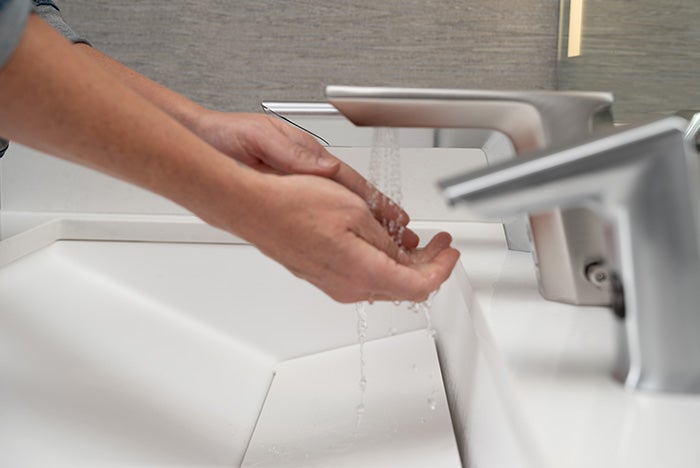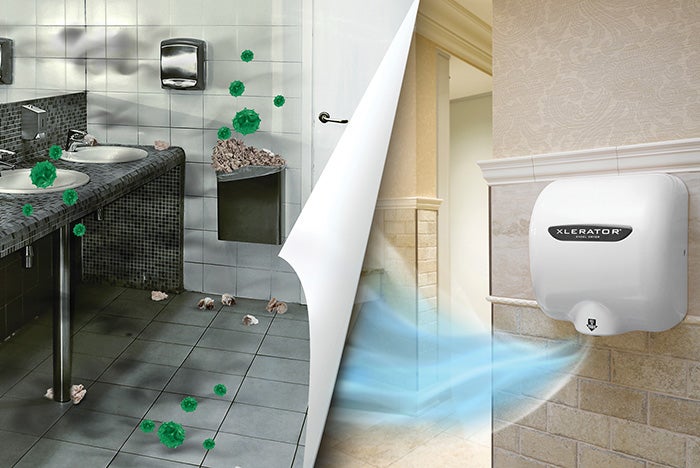Reinventing restroom cleanliness in health care

Several studies show that touch-free products are becoming the preferred option in public restrooms.
Image courtesy of Excel Dryer
The COVID-19 pandemic shifted the global perception of hygiene and its impact on health. As hand-washing took on central importance in minimizing viral transmission, the public’s sensitivity to cleanliness and safety in shared or public spaces increased exponentially. Technologies like touch-free operation and HEPA filtration became expected and even demanded of public facilities, particularly of health care facilities. Facility managers found themselves facing hygiene as a top concern and restrooms were under higher scrutiny. The challenge was in simultaneously satisfying the facility’s own hygienic requirements while satisfying users’ expectations and, as always, keeping costs down.
The perception of “clean”
There is some difference between what one might call “perception of cleanliness” and the science of hygienic efficiency — though the latter certainly informs the former. Perception of cleanliness refers to a visual first impression. According to a 2023 global survey, “What is Considered a Dirty Public Restroom in the United States? A Study of Key Stakeholders,” conducted by MetrixLab, the majority of U.S. consumers find that a dirty restroom lowers their overall impression of an organization or facility. Specifiers polled in the same survey place hygiene and cleanliness among their top considerations when planning a restroom. But what makes a restroom appear “dirty?” Primarily, paper towels on the floor, according to 92% of facility managers surveyed. That’s not to mention overflowing waste baskets and toilets clogged with paper towels improperly discarded.
Hand dryers remove the element of paper waste altogether, saving hours in maintenance and contributing to a cleaner appearance. Hand dryer technology has advanced to the point at which there are multiple options available, from wall-mounted units to in-sink fixtures. Design and efficiency have increased enough to allow for slim-profile units with modest footprints, like the ThinAir from Excel Dryer, and custom options that allow dryers to blend with existing restroom decor. The visual impression is clean, sleek and modern, making a statement about a facility’s commitment to cleanliness and hygiene. Optional electrostatic HEPA filtration (eHEPA®) has been proven to remove 99.999% of viruses and 99.95% of bacteria from the airstream. Ecological benefits and energy efficiency only augment the positive impression.

Hand dryers with elctrostatic HEPA filtration can help decrease infection risks.
Image courtesy of Excel Dryer
Touch points are also a major factor in perception of cleanliness and hygiene. People are more hesitant than ever to touch any bathroom surface and are relieved and reassured by touch-free options. Thankfully, there are plenty of options available for touch-free soap dispensers, touch-free faucets and touch-free hand dryers. Sensor-activated XLERATOR® hand dryers put the user at ease. Optional wall signage touting the dryer’s air filtration technology will further assure a user of their safety.
When looking to minimize touch points, the ultimate solution is a fully integrated, touch-free hand-washing system. The XLERATORsync, for example, is a sleek and compact sink-mounted, touch-free hand dryer that integrates seamlessly with all-in-one solutions like the D|13 Groups, D|Cor or D|Verse sink systems. These systems combine the hand dryer with a high-efficiency soap dispenser and faucet on the sink deck, allowing users to wash, rinse and dry hands all in one place — without ever having to touch a surface. The impression is one of safety and hygiene, indicating the facility’s dedication to well-being. These systems also raise the aesthetic standard of the restroom, lending it the modern, technologically advanced impression people expect of a health facility.
The facts of hygiene
When it comes to meeting actual quantifiable standards for hygiene, facilities managers need to look at the data. Hundreds of studies have been funded to determine the hygienic benefits of various hand-drying methods, but not all studies are created equal. In 2020, University of Arizona researchers published a review of the available material.
“Some of the top-ranking articles in our Google search were white papers authored or sponsored by paper companies,” says Kelly Reynolds, MSPH, Ph.D., the director of the university’s Environment, Exposure Science and Risk Assessment Center. “Additionally, media reports frequently used sensationalized headlines. While such headlines may increase traffic, they sometimes overgeneralize or exaggerate research results. Consumers may only read the headlines which can influence public opinion toward biased or erroneous conclusions.”
Reynolds and her team culled the data, including published studies, news reports and online content, seeking to uncover which hand-drying method — hand dryers or paper towels — is more hygienic and safer relative to human infection risks.
“From a health and safety perspective, we found no empirical data to support one hand-drying method [hand dryers vs. paper towels] over another,” Reynolds says.

Eliminating hand-drying towels can help reduce cleaning and maintenance costs in addition to the spread of bacteria and viruses.
Image courtesy of Excel Dryer
From this level playing field, hand dryers take the lead over paper towels thanks to offering fewer touch points and the option of advanced air filtration technology. Hands-under dryers — particularly those with touch-free activation — eliminate the multiple, unnecessary touch points that come with using paper towels and prevent the germ-laden waste those towels would become. Studies have shown that unused paper towels made from recycled fibers can contain germs including the flu virus, Bacillus and E. coli.
An eHEPA filtration system — which proved to remove 99.999% of viruses from the airstream according to testing done in 2020 by LMS Technologies Inc., Bloomington, Minn., — delivers clean, filtered, purified air fast and efficiently. eHEPA filters contain electrostatically charged polypropylene microfiber, which actively attracts particles, including viruses and bacteria, as they move through the dryer. And they do so while maintaining low pressure drop, requiring less energy to push air through the filter media than other methods, maximizing efficiency and achieving greater airflow without sacrificing hygienic efficacy. eHEPA technology is currently available for the entire Excel Dryer product line.
Installing an antimicrobial wall guard with a wall-mounted dryer will contribute significantly to a reduction in viral transmission and help keep excess water off the floor.
Increasing standards, decreasing costs
For health care facility managers, cost is a major determining factor in the fixtures and appliances they choose to install. To maintain a visual impression of cleanliness, managers of facilities using paper towels must devote costly maintenance hours stocking towels, emptying trash, clearing the floor and dealing with any clogs resulting from improper disposal. Installing Excel Dryer’s XLERATOReco® model to replace paper towels results in an average cost savings of 99.7%, realizing a return on investment within 10 to 12 months.
The Earth factor

Excel Dryer offers solutions in varying sizes and capabilities to help meet every health care facility's need.
Image courtesy of Excel Dryer
If hygiene is top-of-mind for the post-pandemic public, it is joined there by the ongoing concern for sustainable, eco-conscious solutions. An organization’s sustainability goals should be reflected throughout the business and facilities, and restrooms are no exception. Drilling down into the full life cycle analysis of paper towels versus hand dryers, we see hand dryers once again coming out on top. When replacing paper towels for hand-drying, XLERATOReco results in an 81.25% reduction in carbon footprint.
A recent comparative life cycle assessment conducted by TrueNorth Collective comparing the total environmental impact of hand dryers to that of paper towels shows that hand dryers reduce environmental impact up to 94%! But it’s important to keep in mind that not all hand dryers are created equal. To understand whether a hand dryer is truly environmentally friendly, it’s worth checking to see if it has an Environmental Product Declaration, which assesses the impact a product will have on the environment through the study of its energy consumption during production, usage and disposal. Third-party certifications and licensure ensure facility managers and restroom users alike that the organization values eco-consciousness and goes the distance to verify the ecological benefits of its materials and appliance solutions.
Where perception and science meet
When a restroom is optimized for hygiene, user perception of cleanliness will follow. MetrixLab, Chicago, recently conducted a survey on post-pandemic restrooms and found that the top two reasons consumers in the United States find a restroom “dirty” are: 1) paper towels on the floor and 2) overflowing trash bins.
Being sensitive to public expectations and following the data leads us to determine that the safest, most hygienic, most cost-effective and ecologically responsible hand-drying solution is an advanced electric hand dryer with eHEPA filtration. Excel Dryer, a U.S. manufacturer, offers sizes, options and styles to meet every facility’s demands and help users feel safe and comfortable.
Josh Griffing is director of marketing and international sales at Excel Dryer Inc. in East Longmeadow, Mass.




